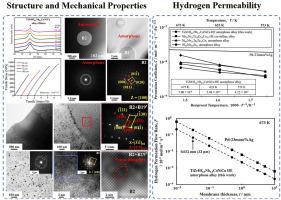高熵TiZrHf0.5Nb0.5CoNiCu非晶态和非晶态+ B2合金的形成能力、热力学性能和氢渗透性能
IF 14.3
1区 材料科学
Q1 MATERIALS SCIENCE, MULTIDISCIPLINARY
引用次数: 0
摘要
在32 ~ 102 μm厚度的熔融纺丝带中合成了非晶态(Am)和Am+B2混合相的高熵TiZrHf0.5Nb0.5CoNiCu合金。厚度在80 μm以下的带状结构由Am相组成,厚度较大的带状结构由Am+B2相组成。B2相呈球形,其直径为0.5 ~ 5 μm,体积分数为0.5 ~ 5%,而厚度为102 μm的条带的体积分数约为5%。非晶相和B2相的合金成分没有差别。Am相经Am→Am′+B2→B2+Cu10Zr7+bcc-Nb两个阶段结晶。B2析出相的粒径极细,约为20 ~ 30 nm,体积分数高达60 ~ 70%。非晶+B2相带(厚度为102µm)的屈服强度和断裂强度分别为950和1523 MPa,塑性伸长率为1.64%,表明混合相合金发生了显著的应变硬化。B19′在B2相中、B2和B19′在Am基体中以及Am/B2界面处的析出是导致合金应变硬化的主要原因。在673 K下,32 μm Am合金片材的氢渗透率最高,为7.00 × 10−9 mol m−1 s−1 Pa−1/2,表明单位时间内的氢渗透量与100 μm Pd-Ag合金片材相当。HE Am和Am+B2混合相合金具有良好的拉伸力学性能,具有明显的应变诱导析出引起的应变硬化和较好的氢渗透能力,这一事实鼓励了HE Am和Am+B2混合相合金的未来实际应用。本文章由计算机程序翻译,如有差异,请以英文原文为准。

Formation ability, thermal/mechanical properties and hydrogen permeability of high entropy TiZrHf0.5Nb0.5CoNiCu amorphous and amorphous plus B2 alloys
High entropy TiZrHf0.5Nb0.5CoNiCu alloys with amorphous (Am) and Am+B2 mixed phases were synthesized in the melt-spun ribbons with different thicknesses of 32 μm to 102 μm. The as-spun structure consists of an Am phase for the ribbons with thicknesses below 80 μm and changes to Am+B2 phases for the ribbons with larger thicknesses. The B2 phase has a spherical morphology and its diameter and volume fraction are 0.5–5 μm and approximately 5% for the ribbon with a thickness of 102 μm. No difference in alloy composition between amorphous and B2 phases is recognized. The Am phase crystallizes through two stages: Am→Am'+B2→B2+Cu10Zr7+bcc-Nb. The B2 precipitates have extremely fine particle sizes of approximately 20–30 nm, and their volume fraction is as large as approximately 60–70%. The tensile yield and fracture strengths of the amorphous+B2 phase ribbon (102 µm in thickness) are 950 and 1523 MPa, respectively, and its plastic elongation is 1.64%, indicating that remarkable strain-hardening occurs for the mixed phase alloy. The reason for the strain-hardening seems to originate from the strain-induced precipitations of B19′ in B2 phase and B2 and B19′ in Am matrix as well as at the Am/B2 interface. The highest hydrogen permeability for the Am alloy sheet of 32 μm in thickness was 7.00 × 10−9 mol m−1 s−1 Pa−1/2 at 673 K, indicating that the hydrogen permeation amount in a unit time is comparable to that for the commercial Pd–Ag alloy sheet with a thickness of 100 μm. The knowledge that the HE Am and Am+B2 alloys exhibit good tensile mechanical properties with distinct strain-hardening caused by the strain-induced precipitation as well as rather good hydrogen permeation ability encourages the future practical use of HE Am and Am+B2 mixed phase alloys.
求助全文
通过发布文献求助,成功后即可免费获取论文全文。
去求助
来源期刊

Journal of Materials Science & Technology
工程技术-材料科学:综合
CiteScore
20.00
自引率
11.00%
发文量
995
审稿时长
13 days
期刊介绍:
Journal of Materials Science & Technology strives to promote global collaboration in the field of materials science and technology. It primarily publishes original research papers, invited review articles, letters, research notes, and summaries of scientific achievements. The journal covers a wide range of materials science and technology topics, including metallic materials, inorganic nonmetallic materials, and composite materials.
 求助内容:
求助内容: 应助结果提醒方式:
应助结果提醒方式:


